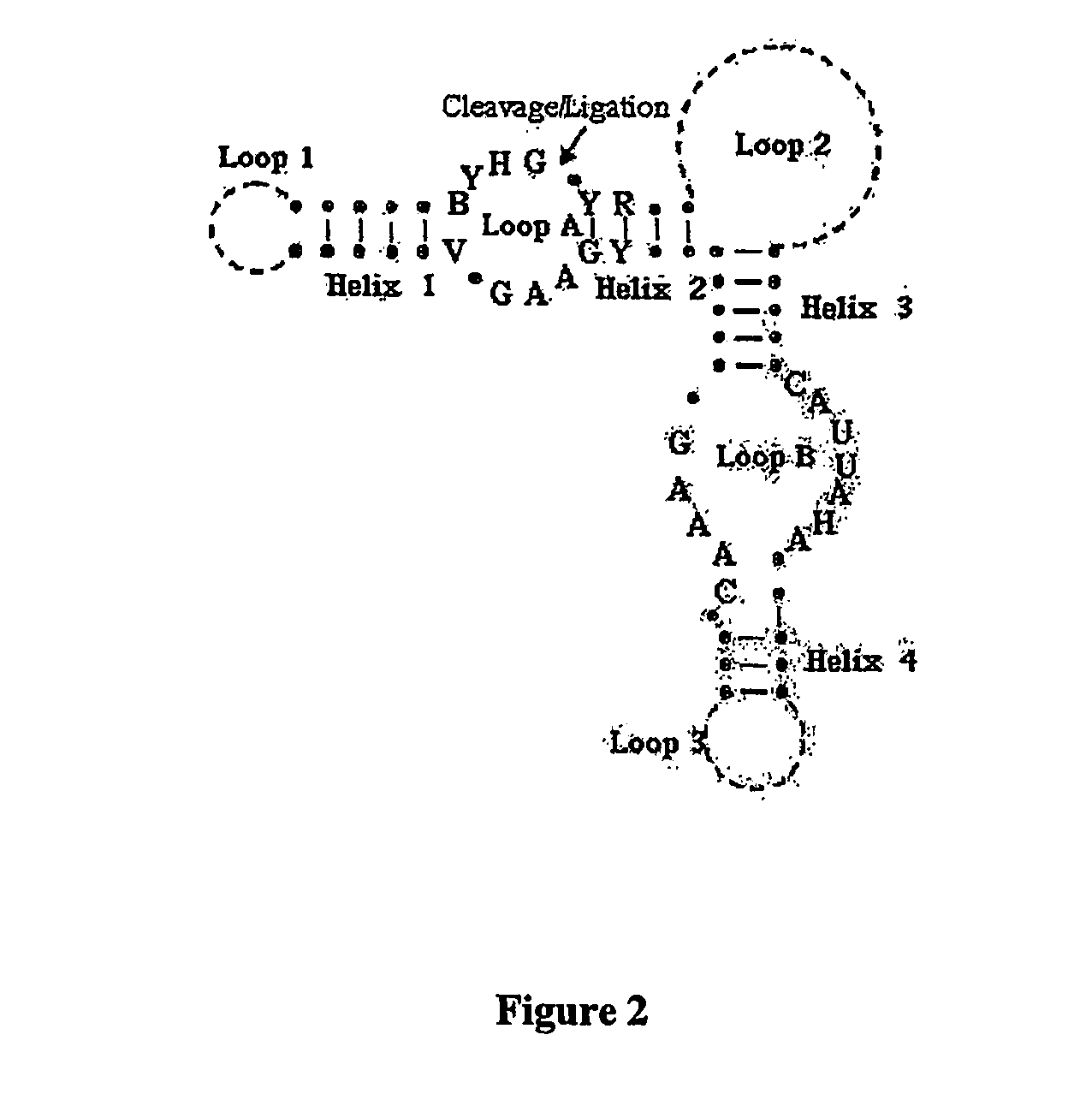Polynucleotides capable of target-depedent circularization and topological linkage
a technology of polynucleotide and target, applied in the field of polynucleotide capable of target-depedent circularization and topological linkage, can solve the problems of competition that may significantly decrease the potential lasso off-target binding, and has not been described to regulate cleavage and ligation activity, so as to increase the sequence specificity of target recognition and binding, reduce potential lasso off-target binding, and high selectivity of oligonucleo
- Summary
- Abstract
- Description
- Claims
- Application Information
AI Technical Summary
Benefits of technology
Problems solved by technology
Method used
Image
Examples
example 1
Preparation of Series of Allosterically Regulatable Lassos with Varying Allosteric Regulation Element from 5-10 Base Pairs and Assessment of Target-Dependent Circularization
Construction of DNA Template for in vitro Transcription of Lassos
[0132] A series of six Lassos containing from 5-10 internal base pairs to the antisense sequence (nt 229-248 of murine TNFα RNA) were constructed (229-5,229-6,229-7, 229-8, 229-9,229-10), as shown in FIG. 8. For each Lasso, four overlapping DNA oligonucleotides were used. Two overlapping, internal oligonucleotides were annealed and overhangs were filled in by Klenow extension. The other two oligonucleotides were primers used to amplify the, rest of the sequence by PCR.
[0133] Two partially complementary overlapping oligonucleotides were used for 229-5 through 229-10 as follows (shown in 5′-3′ direction):
(SEQ ID NO:1)CGTCCGTATGACGAGAGAAGCTGACCAGAGAAACACACGACGTAAGTCGTGGTACATTACCTGGTAACAGAGGC (74 nt)(SEQ ID NO:2)TGTTGTTGTTGTTGTTGTTGTGCCTATGTCTCAGC...
example 2
Lasso Self-Processing and Target Binding Assays
[0137] Assays were performed using internally-radiolabeled Lassos, incubated either alone or with an excess of TNF2 target RNA (cold) at 37° C. for 120 minutes in one of three buffers: (i) 50 mM Tris-HCl, pH 7.5, 10 mM MgCl2; (ii) 50 mM Tris-HCl, pH 7.5, 10 mM MgCl2, 20% formamide volume / volume; (iii) 20 mM HEPES, pH 7.3, 140 mM KCl, 10 mM NaCl, 1 mM MgCl2, 1 mM CaCl2. Reactions were quenched with an equal volume of loading buffer containing 90% formamide, 10 MM EDTA, 0.01% bromophenol blue, 0.01% xylene cyanol. Samples were analyzed on 6% PAGE / 8M urea / 0.5× TBE gels and were electrophoresed at 11 Watts for approximately two hours. Gels were dried and either directly scanned by phosphorimager or exposed to X-ray film.
example 3
Self-Processing Activity of Allosterically Regulated Lassos and Effect of 20% Formamide in the Processing Buffer
[0138] Lassos 229-5 and 229-6 (five and six base pair regulatory sequences, respectively) were able to fully self-process both 5′ and 3′ ends as evidenced by linear and circular gel bands (FIG. 10). Lassos 229-7 through 229-10 did not circularize when incubated without target RNA, and so were allosterically regulated. The presence of 20% formamide in the assay buffer improved Lasso self-processing (FIGS. 10 and 11).
PUM
| Property | Measurement | Unit |
|---|---|---|
| pH | aaaaa | aaaaa |
| pH | aaaaa | aaaaa |
| pH | aaaaa | aaaaa |
Abstract
Description
Claims
Application Information
 Login to View More
Login to View More - R&D
- Intellectual Property
- Life Sciences
- Materials
- Tech Scout
- Unparalleled Data Quality
- Higher Quality Content
- 60% Fewer Hallucinations
Browse by: Latest US Patents, China's latest patents, Technical Efficacy Thesaurus, Application Domain, Technology Topic, Popular Technical Reports.
© 2025 PatSnap. All rights reserved.Legal|Privacy policy|Modern Slavery Act Transparency Statement|Sitemap|About US| Contact US: help@patsnap.com



